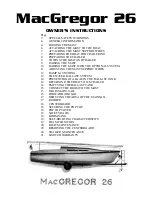
7. PREPARING THE TRAILER
LUG NUTS:
It is the owners responsibility to check the lug nuts that se-
cure the wheels to the axle before using the trailer. The wheels
may have been removed in order to ship the boat to you or
your dealer, and it is important for you to check to see that
the lug nuts have been properly tightened. If they are loose,
you may lose a wheel, with serious consequences. They
should be TIGHT. The proper setting, using a torque wrench,
is 90 to 95 foot pounds. Don’t move the trailer one foot
before checking these nuts.
TIRE REGISTRATION:
It is a federal law that the first licensed purchaser of any
vehicle with tires register the tires with the vehicle manu-
facturer. This is done by completing the Tire Registration
data on your warrantee card and returning it to MacGregor.
Your name, address, tire serial numbers, trailer serial num-
ber and date of purchase must appear on this card.
TIRE PRESSURE:
Before using the trailer, check the tire pressure. The recom-
mended pressure can be found on the sidewall of the tire
near the tire size. Always check the tire pressure when the
tires are cold. Under inflation can cause excessive sway at
certain speeds and could cause loss of vehicle control. Over
inflation could cause a tire to blow out, which also is very
dangerous. Check tire pressure at frequent, regular intervals.
HITCHING UP:
Place the trailer coupler over the ball on your car, and make
sure the snap latch is all the way down and locked. Try to
lift the trailer off the ball to make sure the hitch is securely
fastened to the ball. Insert a 1/4 x 1 1/2" bolt and lock nut
thru the locking hole in the tongue to make sure the trailer
doesn’t jump off. Tongue weight should be between 200
and 250 pounds.
The ball should be 2" in diameter. You are responsible for
making sure that the trailer hitch ball is secured properly to
your car. Get some qualified help in mounting the hitch to
the solid structure of your vehicle.
SAFETY CHAIN:
Secure the safety chain to a solid bumper brace or through
the hole normally provided in your hitch. Leave enough slack
so that the trailer and car may turn without putting tension
on the chain. Secure the end of the chain to itself with the
locking device mounted on the end of the chain. This must
be a solid connection.
TOTAL WEIGHT:
The weight of the boat, trailer and all other items cannot
exceed 2750 pounds. The empty boat weighs 1675 pounds.
The trailer weighs 525 pounds. All other gear cannot ex-
ceed 550 pounds.
LIGHT WIRES:
Our trailers come with a trunk harness (you will find it
plugged into the trailer harness near the hitch). The exposed
ends of the trunk harness must be wired into the light wiring
of your car. The other end should be plugged into the trailer
wiring harness. The wires on the trunk harness and trailer
wiring are color coded as follows:
White - Ground
Brown - Running lights or tail lights
Yellow - Left turn signal and brake light
Green - Right turn signal and brake light
Make sure you have a good ground or you won’t have lights.
The light mounting brackets and ground wire must contact
metal (you may have to scratch through the paint). Don’t
use the trailer unless all lights are working. You must have
the following:
1 red tail light at each rear corner of the trailer.
1 red clearance light mounted on the side of each tail
light.
1 clear license plate illuminator.
1 amber clearance light mounted at the outboard rear
corner of each fender. (These must be visible from
the front.)
You must have 2 red lights at the extreme rear end of the
load (normally on the end of the mast). During the day, a
red flag may be used. Here again, check your state laws for
this and other requirements that you have to meet.
If your trailer has brakes, make sure the ground wire is con-
nected to the trailer frame, and not to the moving portion of
the brake actuator.
HYDRAULIC (SURGE) BRAKES:
State laws concerning brakes vary. Check with your dealer
or with your appropriate state agency to determine whether
or not trailer brakes are required in your area.
If your trailer is equipped with brakes, read the following
carefully to make sure you understand their operation.
When you apply your car brakes, the trailer will try to push
forward against the car. This push compresses the actuator
mounted as part of the hitch, which applies force to the master
cylinder, which creates hydraulic pressure to operate the
Summary of Contents for 26
Page 13: ......








































